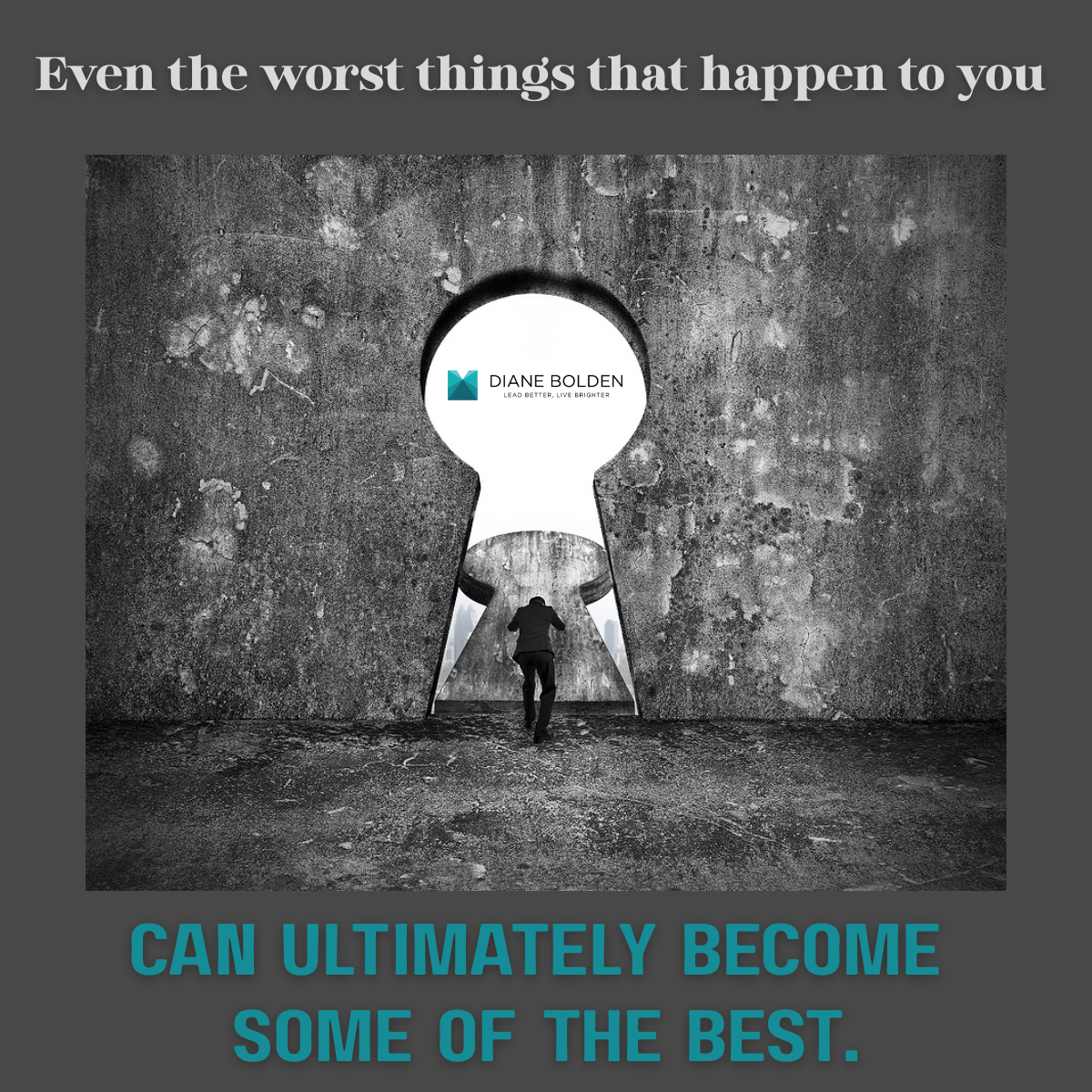Category Archives: Guidance
Miracles in Disguise: How the worst things that happen to you can become some of the best
I’ve worked with a handful of clients who unexpectedly lost their jobs after working for over twenty years with the same company. The funny thing is these people knew they were ready for something greater before it happened. In coaching meetings, they’d often talk about wanting to strike out in new directions, take on bigger challenges, live and lead in a deeper and bolder ways than before. And few of them would have likely sought out new opportunities if things hadn’t worked out the way they did.
In the midst of the changes, it’s likely that they felt as though their universes were falling apart. Much of what was familiar was ending as they were thrust into a world where nothing was certain and forced to begin again. They were brought face to face with the question, “what do I most want for myself now?” and challenged to take action that would lead them in new directions.
It seems more of us are asking the question, “What do I most want for myself?” Some feel ready for new adventures. Others long for deeper connections with people. Many just want to experience the same passion for their work and their lives that they did when they were younger – to feel a part of something bigger than themselves, to work at something worth working for, and to bring more of their true talent and gifts into the world.
And the world needs those talents and gifts more now than ever.
When we come to a place where we’re willing to open ourselves to the question of what we most want, we set into motion a series of events that bring the answers we seek. And sometimes they come in packages we don’t immediately appreciate.
But as we look back on our lives, we can begin to see that the very things that frustrated and pushed us to our limits were exactly what we needed to know more about who we are and what we are here to do.
As Thanksgiving nears, I’m grateful not only for my many blessings but also for my unanswered prayers – those that would have led me in a direction that wouldn’t have served me or others in quite the same way.
I am grateful for the difficult people in my life, who have challenged me to look at things (including myself) differently and find new ways of relating. I am thankful for the trials I didn’t think I could endure and the resilience and courage I was able to tap into because of them. And I am grateful that over time I have been able to laugh at the things that happen to me as well – and for the people who have been there (or somewhere similar before) who have laughed (and sometimes cried) right along with me.
I am grateful for every client I have ever worked with who has given me the opportunity to learn from their experiences and to see one more example of the strange and wonderful ways that miracles manifest themselves in everyday life.
I wish for you (and myself) the ability to always appreciate the blessings that always surround us – the ones that lift us up as well as the ones that seem to strike us down. And to open ourselves to the ways every one of them has the transformational power to bring us closer to our most precious dreams and visions.
Happy Thanksgiving!
3 Steps for Escaping the Hamster Wheel

Do you find yourself running from one thing to the next with little time to think about what you’re doing and why?
If you said yes, you’re not alone.
Many high achieving professionals feel they have way more to do than time to do it. Their ambition, drive, and passion have served them well, but they know they’re capable of more. More opportunity, more impact, and dare I say – more freedom to enjoy their careers and their lives.
The daily grind keeps us tethered to the ground, thinking our best is just around the corner if only we can get through what’s in front of us – often an accumulation of projects and commitments that grows far faster than it shrinks. Occasionally, it becomes apparent that something’s got to give.
But who has time to slow down when there’s so much more to get done?
The fantasy many of us have bought into is that if we just work longer and harder, we will get there. And despite our longing to find balance and the sweet spot that will finally allow us to relax and be more effective, we often act in ways that bring greater levels of anxiety and toil.
As leaders, we also unwittingly create entire cultures of people who emulate our frenetic behavior in the name of getting ahead.
The hamster in the wheel doesn’t know he isn’t getting anywhere.
And before he can, he must realize that he is, in fact, in a wheel. Our wheels are much more sophisticated and deceiving than those of the hamster. Because initially, our wheels do get us somewhere. It’s just that over time, they lose traction and become stuck in comfortable ruts.
And we don’t realize when we’re stuck, because it doesn’t seem possible to be standing still when you’re running like hell.
How willing are you to recognize that perhaps there is a better way?
All change begins with awareness coupled with desire. To move beyond your madness, try the following:
- Pay attention when you’re feeling anxious, stressed, or tense. Recognize the thought or behavior pattern that may be causing this discomfort. This may be a prime area for a shift.
- Ask yourself some discerning questions such as, “What small, but powerful change could I make today that would allow me to be more effective?” Open your mind to different approaches, processes and greater discernment about what really must be done, when, and by whom.
- Notice what catches your attention in the coming days. The answers to your questions will reveal themselves to you, but you must hold the intention to receive them and be willing to listen.
Once you recognize the patterns and triggers that perpetuate your anxiety, stress, and pressure – and the impact they’re having in your life, they begin to lose their hold on you. As they fall away, you can escape the hamster wheel and take the kind of inspired action that’ll get you where you REALLY want to go.
Here’s to your success!
The Fallacy of Failure… and How to Rise Above It

“What great thing would you attempt if you knew you could not fail?”
~ Robert H. Schuller
Could There be Clarity Hidden in Your Chaos?
Ever have a stretch where work (and life) is filled with unpredictable twists and turns, inexplicable delays, and random disorder?
It can be frustrating, unsettling and unnerving.
Our nature as humans is to seek meaning in the things that happen to us. But when there is no logical explanation, we are left scratching our heads wondering what to make of it.
If you’ve ever driven by a construction site and wondered what was being built, you may have noticed the same kind of disjointed activity… people working diligently, each focused on their own specific task… steel girders, half constructed walls, and unidentifiable objects at various stages of completion.
Upon first glance it likely appears chaotic and messy.
But amidst the sawdust and cement blocks, something pulls it all together. Though you may not know exactly what the larger plan is, over time the construction starts to take shape, and you begin to recognize a room here, and another there. Soon you can start to surmise the purpose and function of each room.
As the walls are plastered and paint is applied, the appearance becomes neater. And suddenly, it is completed in all its glory – a stunning compilation of raw materials, sweat, and focused action.
Perhaps we too build things in this way. It is nice to know in advance exactly what we are building. But at times things may feel chaotic, disconnected and random. We have some experiences that uplift us and others that disappoint. Often, we are without an explanation of why certain events and experiences are taking place.
But maybe underneath it all, there is a larger plan at work.
One that will reveal itself over time. As we undertake each new experience, another wall is constructed, and a new room is being built.
What if we were willing to experience our lives with the same wonder and curiosity with which we look upon that building undergoing construction? And what if we were able to engender that same enthusiasm and optimism in everyone around us?
Are you willing to entertain the thought that somewhere within you, there is a perfect blueprint of everything your life and your leadership will bring about?
And can you delight in the mystery of its gradual unfolding?
“A rock pile ceases to be a rock pile the moment a single man contemplates it, bearing within him the image of a cathedral.” -Antoine de Saint-Exupery
Why is this happening?!
 I recently designed and delivered a workshop for one of my oldest clients to address something that will be as relevant in 5, 10, or 20 years as it is now and impacts us all personally and professionally every day… “How to Survive and THRIVE in Turbulence, Transition, and Transformation”.
I recently designed and delivered a workshop for one of my oldest clients to address something that will be as relevant in 5, 10, or 20 years as it is now and impacts us all personally and professionally every day… “How to Survive and THRIVE in Turbulence, Transition, and Transformation”.
We all have a wealth of experience working through each of those things because they come at us regularly. And the more we do, the better we get at handling them. If you look back on the most challenging times of your life, when you were pushed to your limit (or beyond), when the rug got pulled out from under you, when something came at you that you had no idea how to handle – despite whatever doubts or misgivings you may have had, you got through it.
And you learned a thing or two in the process. Though those times in your personal and professional life are often things you may rather forget, there is much to be gained in realizing just how much they have taught you – and perhaps to consider that they may be preparing you for something greater.
We all have our unique personal and career paths. And we have within us everything we need to reach our fullest potential, which exists within us as seeds that wait for the best conditions to sprout.
Some of our seeds will be like that of the lotus flower. They’ll remain dormant in the mud for years, until the time is right for them to grow roots and to shoot a stem upward toward the light, followed by exquisitely vibrant flowers and leaves.
If the lotus flower can bloom so beautifully from
the thickest and deepest mud, perhaps so too can we.
What’s interesting about creating a vision for something you want to achieve is that life has a way of delivering to you the exact combination of experiences that will prepare you to step into that vision and become the person who can make it real.
Some of those experiences we wouldn’t choose for ourselves.
Many of my executive coaching clients can’t help but ask, “Why is this happening to me?”. And they often tell me months later that without those experiences they initially bemoaned, they wouldn’t have had the strength, stamina, insight, or the ability to accomplish some of the very things they are most proud of.
Consider for a moment the stuff that is being thrown at you – difficulties that threaten to drag you down, turbulence that threatens your stability, and curve balls that keep you on your toes. And remember two things: (1) You have everything you need to rise to those challenges and work through them in ways that allow you to prevail, and (2) In the process of doing so, you’ll continue to develop the strength, resilience, and confidence to rise to the heights you most aspire to.
If you’re interested in one-on-one personalized leadership development or would like to bring a custom-designed workshop into your organization, message me for more information.
Why Letting Go of the Old Helps You Succeed With the New (and How to Do It)
What is it that you are longing to create in the coming year?
And what do you need to let go of to allow it to fully take root?
Every year, we are encouraged to set New Year’s resolutions.
We are a goal-driven society that is conditioned to seek more. Our egos desire more money, more fame and prestige, and more stuff. A deeper part of ourselves longs for more peace, more meaning, and more purpose in our lives.
We want to move beyond our previous realizations of what we’ve already accomplished to master newer, better ways of doing things (in our lives and our organizations) – and as leaders what we can inspire others to do.
Though it is tempting to think about how we can achieve all of this and what we need to do more of, perhaps what we really need to start with is what we need to do less of… what we need to let go of to create the space for something new to come in.
We are constantly evolving both individually and collectively.
It is so easy to look to the past to define who we are through the things we’ve already done: goals we’ve achieved, titles we’ve acquired, creations we have built. Our previous experiences coagulate to form an identity that is easy to confuse with our true nature.
The fact of the matter is,
you are not your accomplishments,
your creations, or the sum of the various roles
you play in your life – manager, director, vice president,
mother, father, friend, son, daughter, etc.
You are much, much more than that.
Your potential is limitless.
And yet, we limit ourselves by these definitions.
They filter the experiences we allow ourselves to have and compel us to define the form that our deepest longings should take. To be happy, we reason – we must get that promotion, achieve this or that particular goal, hit that target. So we continue to go through the motions, doing the kinds of things we’ve always done – on a sort of autopilot.
Some of this may bring satisfaction, and some a growing source of discontentment. We need to attune ourselves to that which brings us the most of what we truly desire and open ourselves to the possibility that what we really want may need to come in a form that has previously been undefined.
In short, we must allow ourselves to surrender what we think we know to fully embrace the mystery unfolding in each of our lives.
Easier said than done, right?
How exactly do you go about letting go of the known when it’s all you know?
We can take our cues from nature. Snakes and other reptiles shed their skin, trees drop their leaves, and caterpillars create cocoons in which their forms entirely dissolve before recreating themselves as butterflies.
Even a fish in a bowl cannot stay in water that contains its excrement – the waste must either be emptied and replaced with new water, or absorbed by something else that will remove it from the fish’s environment.
Without engaging in these renewing processes, these creatures will die. And so it is of us. Many of us are already walking around encased in layers of old, dead stuff that needs to be released.
What are you holding onto in your life that has run its course?
What are the old outmoded ways of doing things that no longer bring you energy? What are the things you’ve acquired that you no longer need? What beliefs are you holding onto that are no longer true for you?
Pay attention to the times that you feel constricted, anxious, or tired and in those moments ask what you can let go of. Don’t be afraid of the answer. Though it may frighten you because it introduces an element of the unknown, following these insights will always lead to freedom and liberation.
Your computer can only handle so much data.
If you do not delete old email and get rid of files that have been accumulating over the years, and if you continue to add new programs without deleting old ones, you will find that it becomes sluggish and unresponsive.
Just as freeing up space allows your computer to process things more quickly, so too will clearing your own personal space (whether of things or thoughts) allow you to access new levels of clarity and creativity.
Space invites opportunity.
You will breathe easier, be more present in every action and interaction you partake of, and bring more of who you really are to what you do. And you will open up the space of possibility that will allow something to come in that may surprise and delight you.
So here’s a thought for the New Year: Instead of trying so hard to do more with less, perhaps we can allow ourselves to explore the possibility that in doing less, we can have so much more.
For more on how to affect your own personal and professional transformation, check out The Pinocchio Principle: Becoming a Real Leader – How to Unleash Genius in Yourself and Those You Lead, available in both paperback and Kindle formats.
Ringing in the New Year: Why Looking Back is as Vital as Looking Ahead
There is something magical about being at the threshold of a new year.
It’s like climbing to the top of a long staircase to find yourself on a landing, standing before a large glimmering door just waiting to be opened. As you look down, you realize how far you have climbed to get here. Yet, you cannot help but wonder what lies behind the door.
Often, we underestimate the amount of growth we have achieved.
It’s important to take some time to reflect on the unique combination of experiences that have led to both successes and disappointments and the learnings that have accompanied them. Doing so cultivates insight that helps you know what to do in the future.
I often work with people who feel ready for a change but aren’t sure what that change should be. They aren’t necessarily miserable in their jobs or other areas of their lives – they just long for something that will fill them up in ways they haven’t been fulfilled in the past.
When I coach people who feel this way, they sometimes want me to tell them what the next best step is – to give them the answer or a step-by-step process that will lead them to find what they seek. Of course, no person has these answers for another. Our greatest challenge and opportunity is to find them for ourselves.
Each of our lives has a story with perfect order and meaning.
As in a novel or screenplay, each character has a unique relationship to the main character, and every scene has some relevance to his growth and evolution. There will be victories and disappointments as well as twists and turns.
We will have occasion to laugh, cry, and experience a myriad of other emotions that are somewhere in between. And as a result of this perfect combination of events and mini-plots, we discover ourselves to be better people.
When reading a book or watching a movie, the perfect order is often easier to see than it is for the characters enmeshed in the stories we are watching. Yet, the mystery and intrigue, the humor over each misstep, and the courage we see the characters exude to find their way give substance to the story and allow us to leave the book or the theatre feeling moved or inspired in some way.
As you reflect on 2024, can you identify your story’s most pivotal turns? What did you learn from them? Think about your character sketch. What are the endearing qualities you have that make you unique and special? How can you leverage them to build on the previous events to create a story worth telling?
Think also about the people that surround you. In what ways are they helping you grow? What are they teaching you about yourself – whether in joyful or painful ways? And what qualities do they possess that are similar to and different from yours? How do you complement each other, and what might it be that you can create together?
You now sit at the threshold of another chapter in your story.
Contemplate what you have already experienced and ask yourself how you might build upon it to add a bit of intrigue and adventure. Identify the ways that you could add a little lightness and humor. Think about the interplay between the characters and how you could spice things up a little.
We have each been given the makings of a beautiful tale. Open your eyes and survey them the way you would the perfectly planned detail of your favorite movie or novel. Give yourself completely to the adventure, the possibilities, and the humor in your life.
Then find a way to revel in the joy of living it.
Here’s to a bright, beautiful New Year!
For more on reveling in the adventure that is your life, check out The Pinocchio Principle: Becoming a Real Leader, available in both paperback and Kindle formats.
How to Unlock the Power of Gratitude
Gratitude allows us to interrupt, if only for a moment, what seems like a perpetual condition of restless yearning. From such an early age, we become conditioned to always look for more – to achieve more, to have more, to become more. With such an orientation, even the fruits of our labor are not fully embraced before we feel compelled to run off and do something else.
Gratitude is a state of being rather than doing.
It is a matter of what we focus on. All of our striving and yearning keeps us fixated on what we do not yet have, but desperately want. It leaves us in a state of lack, feeling as though we must compensate for something. Gratitude reverses that and allows us to soak up and truly experience the fullness of what is already ours. In gratitude, we can fully appreciate the richness of life around us – no matter what it looks like. From that state, we can more fully connect with those we love and appreciate and truly enjoy each moment as it unfolds.
Soon the day we call Thanksgiving will be upon us.
It brings with it the opportunity to celebrate – if only for a day – the richness and bounty that is ours. But this state of appreciation and celebration does not need to stop after the day is done.
For all that we want, there is much that we already have.
When you shift your mind into a state of gratitude, you are likely to act in ways that bring more to be thankful for. As you love and appreciate the important people in your life, you become more lovable. As you give your time and attention to others, you realize there is a place within you from which you have much more to give. Even with the things you really want in life, you can begin to realize the small (and big ways) in which those things are already here – and be fully present to the way they are already unfolding, trusting in life’s beautiful mystery.
No matter who you are or what your life is like, you have something to be grateful for.
It has been said that whatever your place your attention, energy, and focus on will expand. Perhaps this is the true art and power of gratitude – our ability to be in a place of joy and abundance and magnify it in such a way that it truly enhances the quality of our own lives, and everyone around us as well.
Happy Thanksgiving!
Diane
P.S. If you find yourself in an environment that is difficult to appreciate or feel that what you really want is a change of some sort, gratitude might be a difficult place to start to begin crafting your desired future. I work with high achieving executives every day through a curriculum-based coaching program and via one-on-one coaching to help them leverage their experiences to move closer to their ideal vision so they can make a bigger impact doing meaningful, inspiring work and enjoy their lives more – both on and off the job. Message me if you’d like more information.
3 Fundamental Truths to Help You Become What You Most Admire
When Halloween rolls around, it invites the question: if you could be anything for one evening, what would it be?
The tradition invokes a feeling of fantasy. Whether your answer is a super hero or a villain or something in between, the very act of asking the question and imagining a response reminds us that we have the ability, even if for a simple costume party, to explore aspects of ourselves that want to be expressed.
And the invitation to step into a new way of experiencing the world (or projecting what the world experiences of us) doesn’t have to wait for Halloween or stop when it’s over.
Have you ever secretly dreamed of becoming something different than what you are right now? Maybe you’d like to be more of a strategic player, become more visible, make a bigger impact, or lead more people. Perhaps you have visions of learning a new skill, working in a different industry, or serving a different customer base. Or maybe you’d simply like to step into a new way of living and leading – one that allows you to be more confident, calm, and engaging, or less stressed, pressured and anxious.
Regardless of the change you seek, you would not have the desire if you didn’t also have the capability to achieve it. As Napolean Hill once told us, “Whatever you can conceive and believe, you can achieve.” Moving from thought to reality requires that we embrace three simple, yet powerful truths:
- You don’t have to be born with an innate talent to do something in order to learn it,
- You don’t have to eliminate anxiety and doubt in order to perform well, and
- You don’t have to sacrifice who you truly are in order to become who you want to be.
Let’s dig a little deeper into each of these.
You don’t have to be born with an innate talent in order to learn it.
On its face, this statement seems fairly obvious. After all, none of us knew how to walk or talk when we were babies. Many of the things you know how to do today were things you had no idea how to approach at some point in your past. While it is true that some of the things you learned over the course of your life came more easily to you than others, with practice and persistence you were able to increase your proficiency and improve your desired results.
You may think you don’t have the aptitude to learn or become certain things. But the problem may be more in what you are believing than anything. In her ground-breaking book Mindset: The New Psychology of Success, Carol Dweck discusses two different approaches to learning a new skill. Some people operate from a “fixed mindset”, considering talent to be an inborn trait for some (but not others). Others operate with a “growth mindset” which allows for the possibility of learning something that doesn’t come naturally to them. Her research shows that those in the latter group consistently outperform those in the former.
The fundamental difference comes in how those mindsets impact your behavior. With a fixed mindset, you’ll dread failure because you believe it is a reflection of your innate abilities. However, with a growth mindset you’ll be more likely to see things not going well at first as an opportunity to learn and grow in ways that improve your performance. A fixed mindset will lead you to quit before you even start, while a growth mindset will impel you to continue to practice, learn and improve.
The words of Henry Ford come to mind, whether you think you can or you think you can’t, you’re right.
But that doesn’t mean it will come easily, which leads to the next fundamental truth we must embrace.
You don’t have to eliminate anxiety and doubt in order to perform well.
Chances are that whatever you aspire to become is something that is beyond your current zone of comfort. If it wasn’t, you’d already be doing it. As I wrote in The Pinocchio Principle: Becoming a Real Leader, anytime you endeavor to make a change in your life, you will be met with resistance. Whether that resistance takes the form of anxiety or doubt or plain old yellow-bellied fear, no amount of careful learning and preparation will completely alleviate it.
Many of us (myself included) have spent years attempting to hone and refine our skill from a mental level before ever attempting to execute. The irony is the that most impactful and effective way to learn is often to simply do. In doing, we discover what works and what doesn’t and gain an intuitive feel for what we need to adapt to achieve the success we desire. Through trial and error our skill and effectiveness grow.
But the anxiety and the doubt and that little voice in your head that incessantly rattles on in ways that lead you to question your ability and your nerve will continue. If you can see those feelings as signs of progress that you are stepping up your game, you can perform in spite of them – and maybe even begin to appreciate them.
You can also learn to recognize that little nagging voice for what it is: a product of your thoughts and nothing more. As you stop giving it so much of your energy and attention, you may find that you can coexist with it in the same way you tolerate any other irritating but seemingly harmless disturbances, like a rattle in your car or an annoying commercial on the radio.
Sometimes that little voice will ask, “who do you think you are?” which leads us to the third fundamental truth we must embrace to move from desire to reality.
You don’t have to sacrifice who you truly are in order to become who you want to be.
The idea of dressing up implies that we are putting on a mask that eclipses our true identify. But often the things we desire to explore are actually innate parts of ourselves that are ready to emerge. We are drawn to people who exemplify the qualities we want to emulate. Sometimes we are even envious of them.
It is important to honor our own evolution by giving credence to our desire to grow and change and allowing those desires to guide us. They key to being authentic and true to ourselves is to listen to the beat of our own drummer rather than allowing the sheer force of our accumulated patterns, habits and the expectations of others determine our identity. Often the way we have behaved or expressed ourselves over the course of our lives is more a product of what we’ve always done than who we truly are.
So when the idea of trying something new, or exploring a different way of showing up in the world is appealing to you, indulge yourself and see what happens. Finding your own authentic expression is a matter of fine tuning. Try something and see how it feels. You can start by emulating what someone else has done. And then add your own twist. Let go of or tweak what doesn’t work and do more of what feels good to you.
This is what the most impactful of leaders have done throughout the course of history. They start by leading themselves – listening and indulging the desires of their hearts, believing in their ability to grow, evolve and achieve, and finding their own unique expression. And in so doing, they serve as leaders to the rest of us.
So don’t let the fantasy and fun of Halloween stop when October ends. Ask yourself what you’d most like to become and don’t be afraid to see where it takes you. In the words of George Eliot, “It is never too late to be what you could have been.”
If you are interested in more strategies for getting clarity on what you would most like to accomplish, create or become, as well as steps to help you close the gap between desire and reality, download my special report, Why Real Leaders Don’t Set Goals (and what they do instead).









